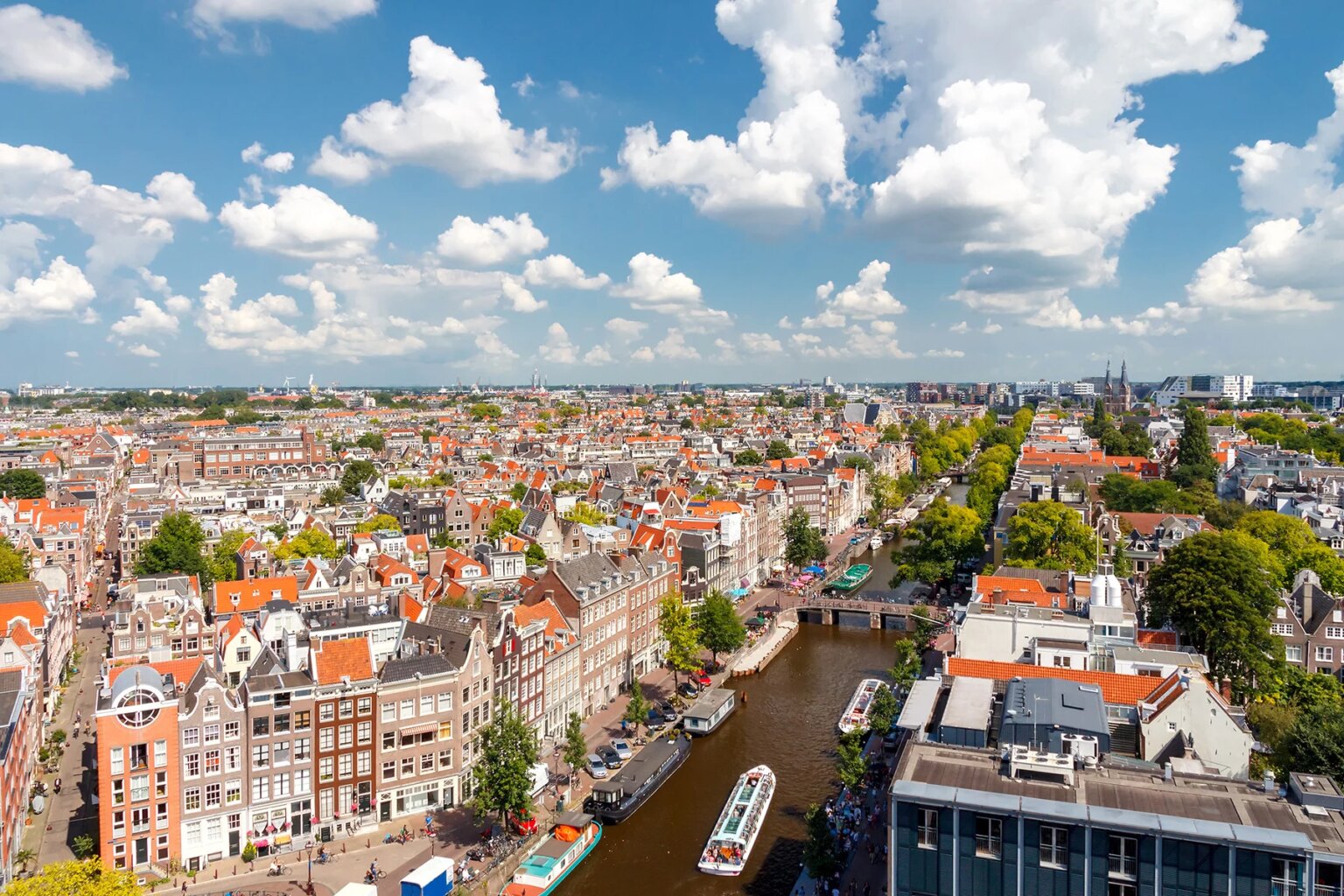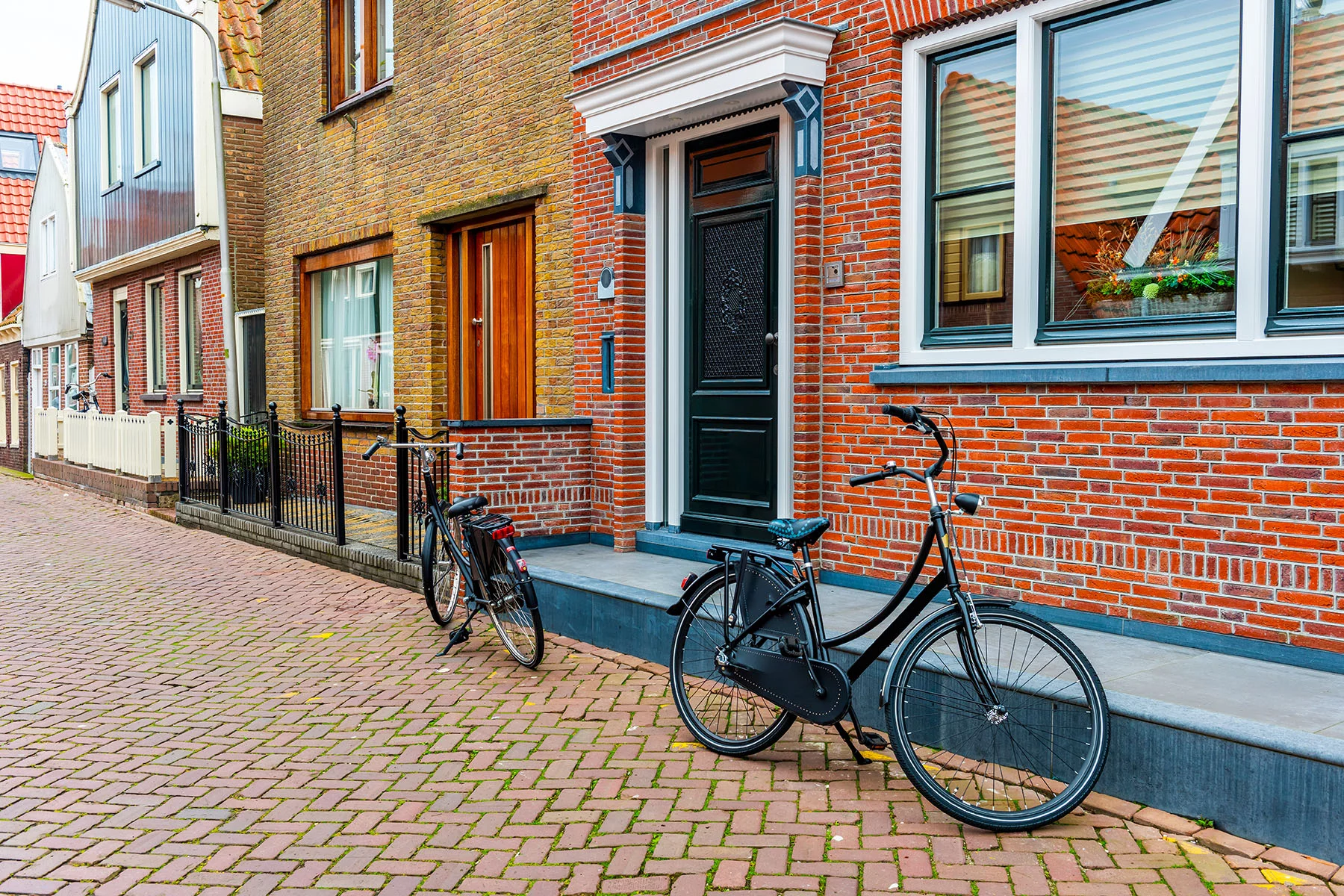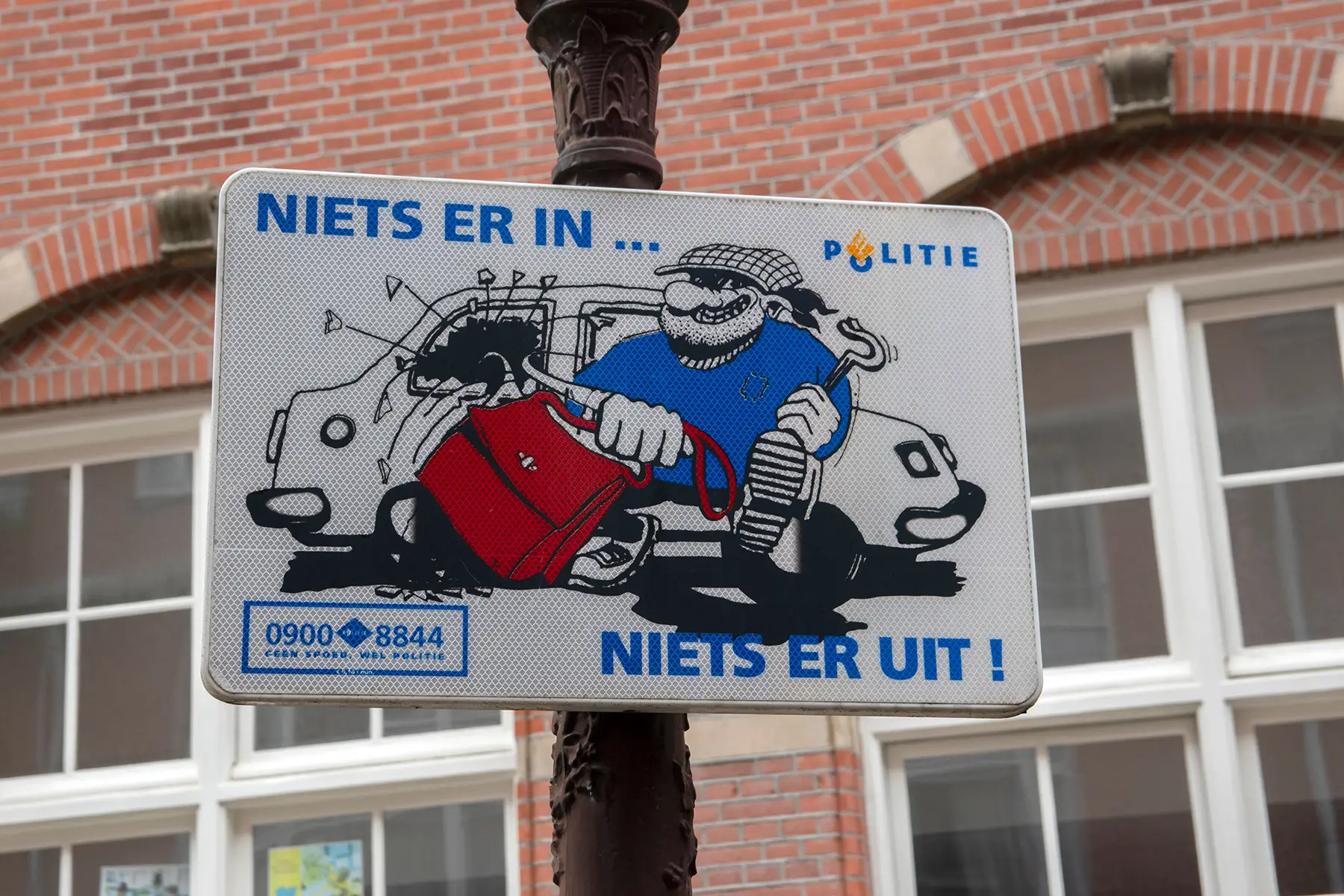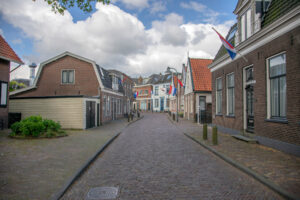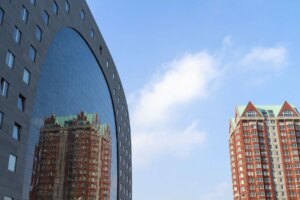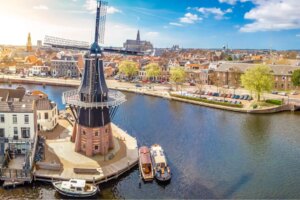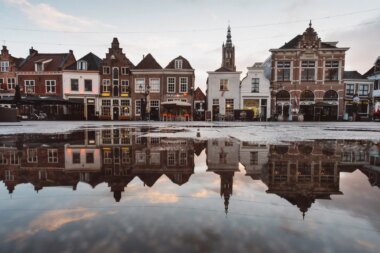It’s no surprise that Amsterdam remains so popular for those seeking a new life abroad. It’s one of Europe’s most beautiful cities; full of life, history, and undeniable charm. The city is big enough to offer plentiful culture and entertainment whilst retaining pockets of tranquility and a laid-back pace of life. With its network of historic canals, tilting townhouses, and stunning parks, it really is a city that has something for everyone.
Amsterdam is home to people of over 180 nationalities making it one of the most diverse cities in the world. This is reflected in the vibrancy of its seven districts, each with its own distinct neighborhoods, characteristics, and feel. To help newcomers get to grips with Amsterdam and decide which area suits them best, we take a look at what each district can offer for you.
HousingAnywhere
Simplify finding a home abroad with HousingAnywhere. Their easy-to-use platform lets landlords and tenants connect, offering a popular service for anyone moving internationally. So, find your new home when relocating abroad quickly and easily with HousingAnywhere.
Introduction to Amsterdam
Originally founded as a 13th-century fishing village around a dam on the Amstel River (hence the name), Amsterdam is in many ways a living, breathing museum that celebrates life on and around the water.
The picturesque city center canals, once used for commerce and transportation, have seen Amsterdam labeled the Venice of the North. The city’s 17th-century canal belt (Grachtengordel) was designated a UNESCO World Heritage Site in 2010. However, Amsterdam’s 100km network of waterways stretches far beyond the center, taking in all seven unique districts.
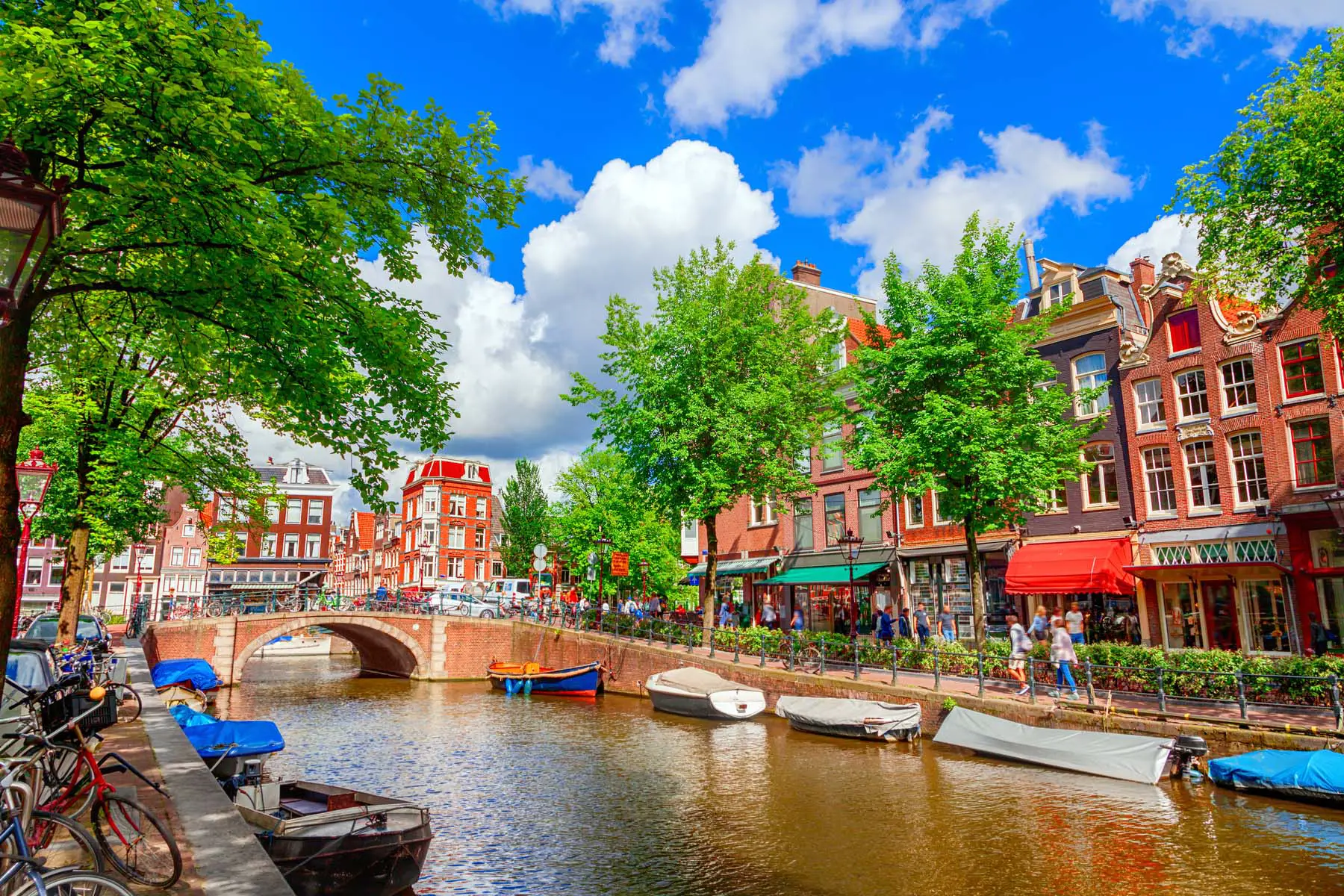
On dry land, the Dutch capital retains a small village feel thanks to its bicycle-friendly infrastructure and vertical living. Indeed, life in Amsterdam often spills out onto its streets. When the sun shines, locals will even take their dining tables outside for a little evening entertainment. Simply put, life is good in Amsterdam. Residents experience a high level of life satisfaction, scoring 8.3 out of 10 in the OECD Better Life Index for work-life balance.
Prior to the COVID-19 pandemic, Amsterdam received over 20 million tourists annually, making it one of the most visited cities in Europe. Amsterdam’s entrepreneurial mindset and strategic location as a gateway to Europe have allowed it to become a frontrunner in a number of sectors including; tech, artificial intelligence (AI), renewable energy, aerospace, health, and creative industries.
With 881,000 bicycles in the capital alone and a vast network of cycle-friendly infrastructure, Amsterdam is easy to navigate on two wheels. However, for those unwilling to cycle when it rains, Amsterdam’s GVB also offers an excellent public transport network of trams, buses, and trains.
It’s not just bikes that are welcome in Amsterdam. The Dutch pride themselves on their tolerance, but the capital goes one step further, welcoming and celebrating diversity. Unsurprisingly, it’s ranked the second most LGBTQ-friendly city in the world.
How to find housing in Amsterdam
Amsterdam is a popular destination for expats and students. Alongside the demand for housing from the local population, this makes for a highly competitive property market. It can be a challenge to find the perfect home in Amsterdam, but with determination, good advice, and the right research, it’s not impossible.
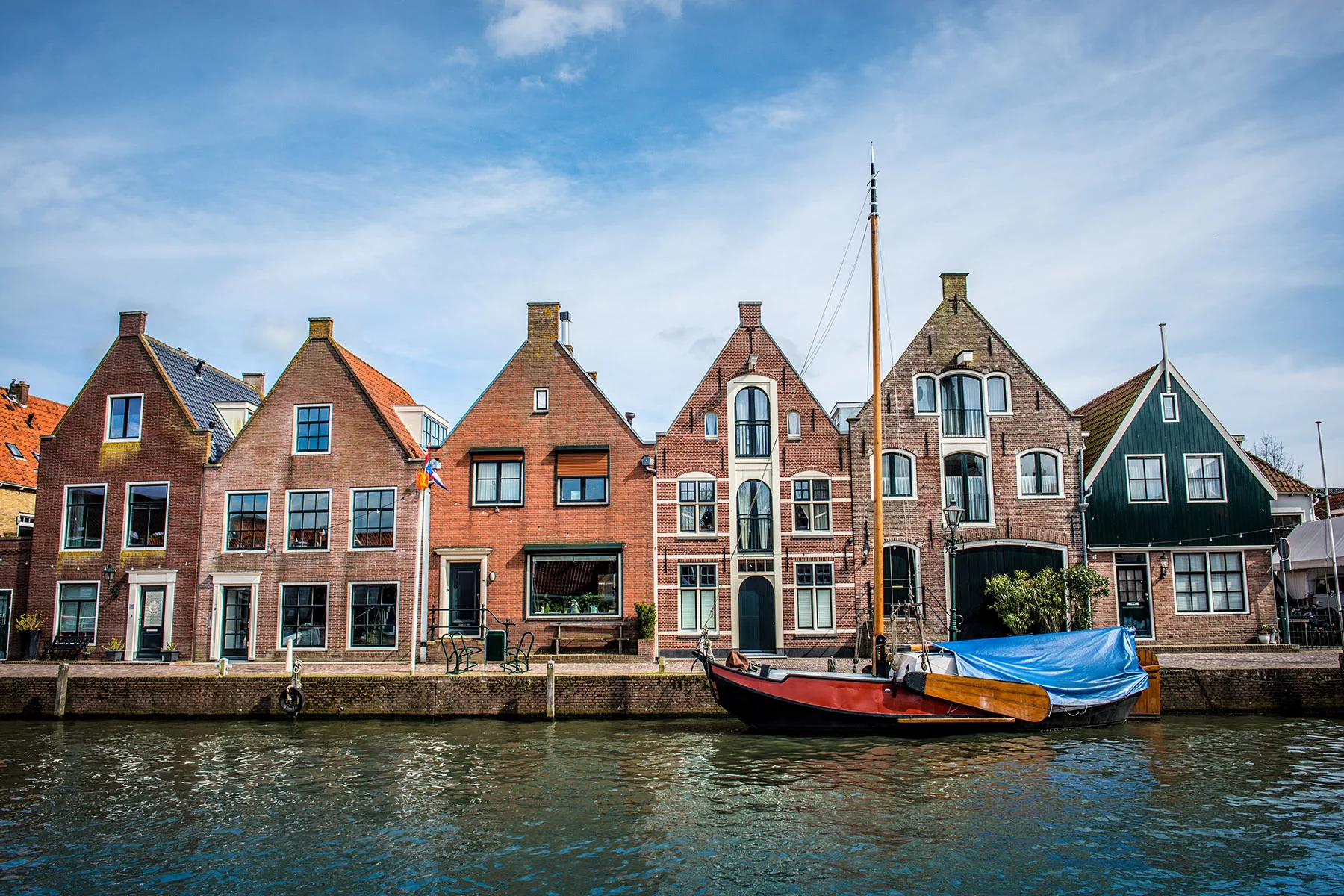
There are a number of expat-friendly estate agents (makelaars). Through the MVA (professional association of expat brokers in Amsterdam), expats can identify certified estate agents with expertise in housing internationals in the city. Should you choose to search for housing yourself, you can find up-to-date rental listings throughout the Netherlands on websites like:
Typical accommodation in Amsterdam
Amsterdam is a city of vertical living, embodied by its iconic canal-side townhouses which are typically four stories high. On average, Amsterdammers have around 49 square meters of living space – well below the national average of 65m2. Compact living is embraced by Amsterdammers, but if your budget allows, it’s also possible to find larger apartments spanning multiple floors. Most apartments have balconies, and many ground-floor properties have small gardens. Depending on the location of your apartment, you may even have access to a shared courtyard garden.
Renting in Amsterdam
If you’re planning to live in Amsterdam for five years or less, your best option would be to find a private rental apartment. Most expats rent within the private sector as social housing in Amsterdam is reserved for low-income groups. There are strict criteria for individuals seeking social housing and there is an 8-18 year waiting list, making it unsuitable for most expats.
Buying in Amsterdam
Anyone planning on staying in Amsterdam long-term may benefit from purchasing a property. There is a lot of competition for properties and in most instances, you will need to bid above the asking price. Some lenders might also require you to take out homeowners’ insurance, which you can find through providers such as
Nevertheless, there are tax incentives and long-term benefits attached to owning your own property in Amsterdam.
Neighborhoods in Amsterdam
Officially, Amsterdam is divided into seven districts. Within these districts, there are multiple smaller neighborhoods, each with its own particular characteristics and charm. However, to keep things simple, we’ll stick to the district level.
Amsterdam Centrum
Fanning out from Centraal Station and encompassing Amsterdam’s iconic UNESCO World Heritage canal belt, Amsterdam Centrum is the beating heart of the city. Its maze of canals and winding streets draws tourists from all over the world. But if you turn your gaze upwards you will see that it is also home to many Amsterdammers. Some of Amsterdam’s most charming (and crooked!) homes can be found in this neighborhood. Most homes are compact, but if you’re lucky you may find a top-floor apartment with magical views across the rooftops.
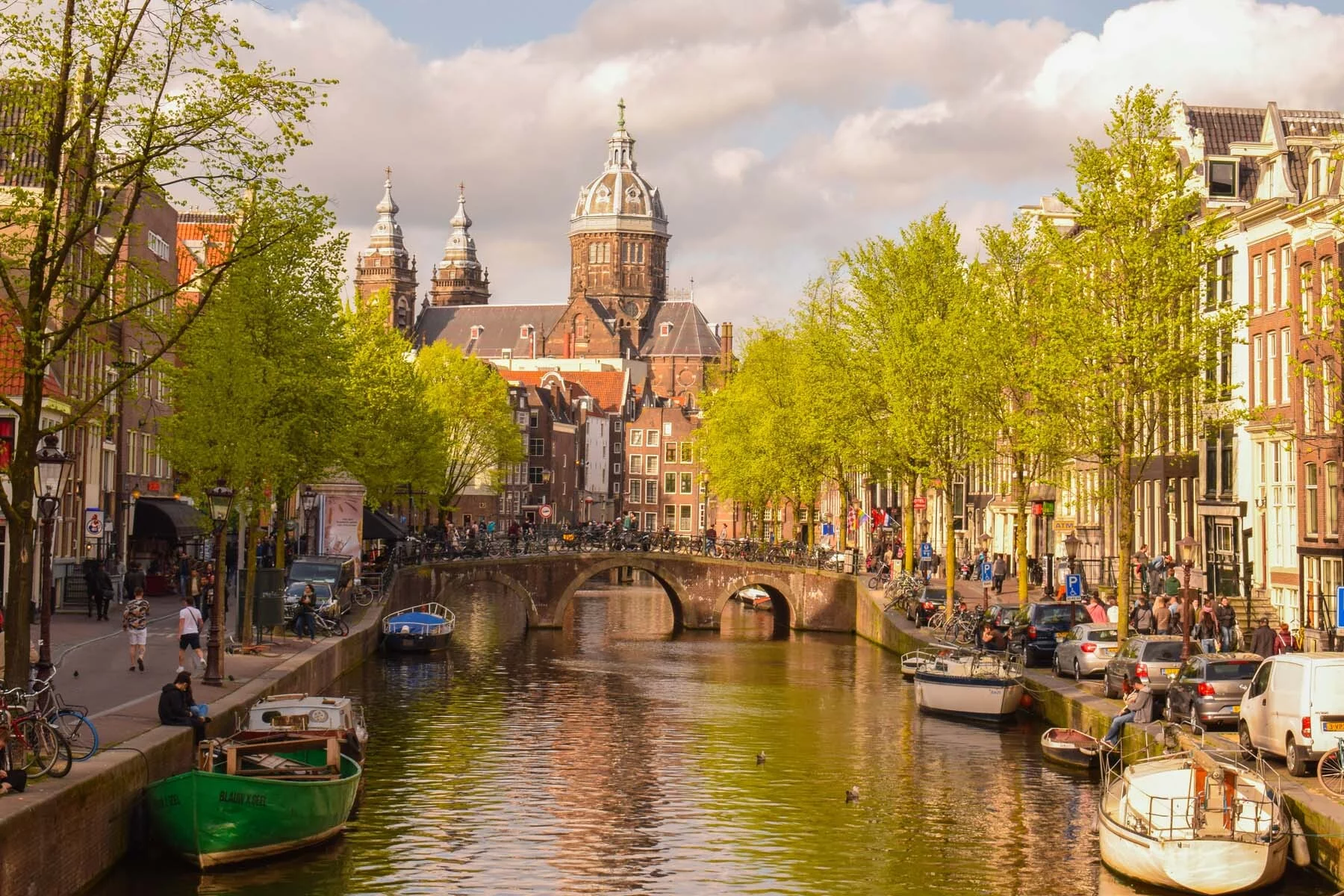
At the heart of the Centrum is the city’s old center, De Wallen. Here, there are theaters, bars, restaurants, nightclubs, and much more. De Wallen is also home to Amsterdam’s infamous red-light district. However, elsewhere in the center, you’ll find the bohemian and very desirable Jordaan, the historic Canal Belt, and finally, the Jewish Quarter.
Environment in Centrum
The old center of De Wallen is the busiest area of Amsterdam and its 24-hour economy means it’s hard to escape the noise here. Despite the constant hum of tourist activity, residents of De Wallen will be rewarded with the historic charm of its tree-lined canals and picturesque townhouses. However, families may prefer Centrum’s outer neighborhoods where tourist activity is less intense.
For those seeking a mix of sophistication, history, and culture, the Canal Belt has it all. As one might expect from a UNESCO World Heritage Site, properties here are pricey. However, the price tags are justified by picture-perfect canal views. This neighborhood is popular with expats looking for a typically Dutch slice of Amsterdam. The Canal Belt is a stone’s throw from the city’s most famous sights and boasts plenty of chic cafes and eateries.
Further to the west lies the bohemian Jordaan, the most famous of Amsterdam’s neighborhoods. The narrow streets are lined with independent shops and hip cafes. Its artistic and welcoming feel makes it popular with families and young people alike. The Jordaan has lots of playgrounds tucked into its crisscrossing streets and is close to the open green spaces of Westerpark.
On the east of the Centrum lies the Jodenbuurt, the historic Jewish neighborhood of Amsterdam. The area is now a vibrant Jewish cultural quarter with many museums and cultural centers.
Despite Amsterdam being a fairly safe city, there is some crime (in Dutch) within the city center. However, the worst you’ll likely experience is bicycle theft or burglary. However, be aware that there is a high concentration of coffee shops selling marijuana in Centrum. Though not technically legal, marijuana is decriminalized in the Netherlands and as such, there is a large amount of cannabis tourism in the area. However, the mayor of Amsterdam is controversially trying to deter this.
Facilities around Centrum
Kalverstraat, the city’s main shopping street winds its way through the heart of the Centrum. Independent boutiques and craft stores can also be found tucked away throughout the Centrum, particularly around De 9 Straatjes (the nine streets).
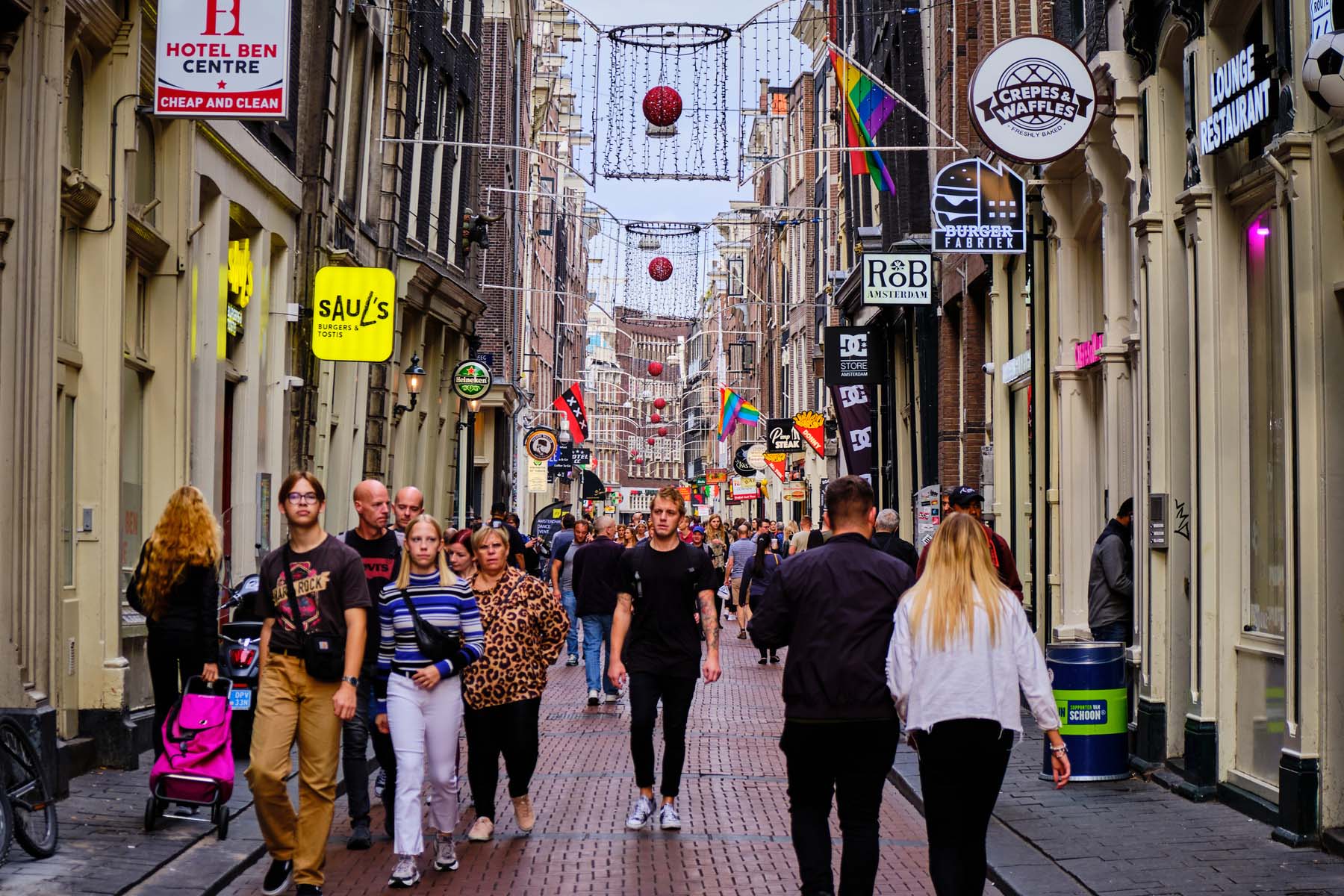
Whatever your tastes or interests, from music and art, to theatres, nightlife, and museums, Centrum has something for everyone. It’s home to some of Amsterdam’s most important cultural sites, including the Anne Frank Museum.
Despite its small size, there are two hospitals (in Dutch) located within the Centrum area and numerous schools.
Transport to Centrum
All metro lines and virtually all tram lines converge or pass through Amsterdam Centraal. From here, NS trains connect you to the rest of the Netherlands, while international services can take you directly to London, Paris, Berlin, or beyond.
One thing the Centrum does not easily accommodate is cars. Limited space means there is a long waiting list for permits (sometimes several years).
Housing in Centrum
On the whole, properties in the Centrum tend to be amongst the smallest in the city. The Jordaan, Canal Belt, and Jewish Quarter may offer a little more space than in De Wallen. However, you will certainly get more bang for your buck beyond the Jordaan and outside of the Centrum area.
Work and business in Centrum
Many small businesses and creative start-ups are based in the Centrum. There are lots of co-working spaces and the city has a good support system for entrepreneurs and businesses in their early stages.
There are also lots of job opportunities in the centrum, particularly in retail, catering, and hospitality. The iAmsterdam job search portal lists jobs for English speakers. It’s also worth walking around the neighborhood as many restaurants and independent stores post job vacancies in their windows.
Why should you live in Amsterdam Centrum?
Amsterdam Centrum is the cultural and historic heart of the city. It offers the postcard-perfect experience of Amsterdam and even the constant throng of tourists can’t detract from its wow factor.
Amsterdam Noord
Take a short (free) ferry ride across the water from Centraal Station and you will find yourself in Amsterdam Noord. A district with many faces. On one side it is a hip, creative area of experimental art and modern living centered on the former industrial areas along the IJ. On the other, it’s large-scale residential areas. And finally, there are plenty of open rural areas further out that are dotted with picturesque villages.
All this gives Amsterdam-Noord a truly unique feel. The repurposed dockyard area is a hub of cultural activity with exciting events, festivals, and waterside eateries and terraces. This area is at the forefront of eco and experimental living and is also home to a number of start-ups and creative enterprises.
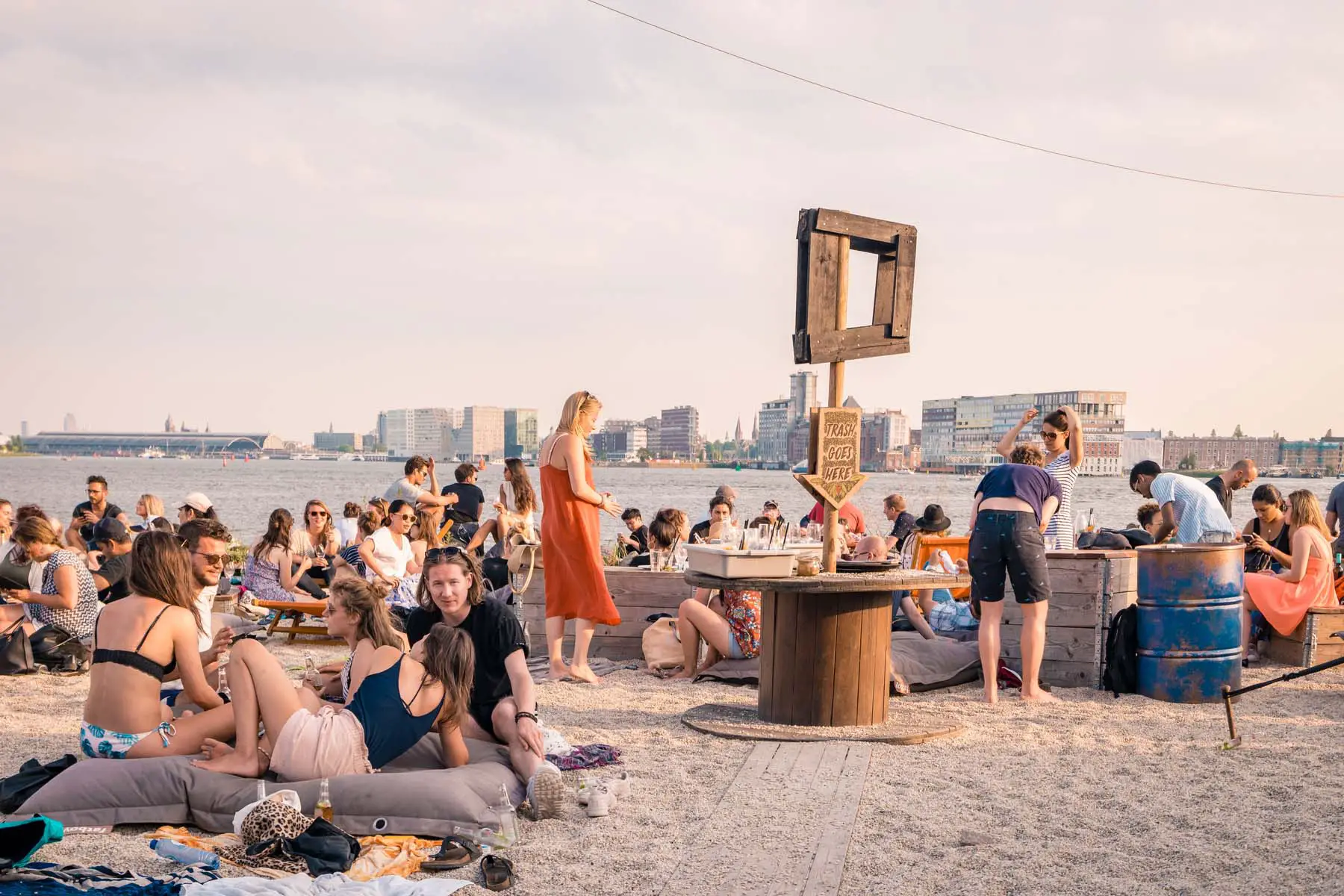
Environment in Noord
Affordable and spacious family homes, combined with good schools (of which more keep appearing) and wonderful parks and open spaces make Noord a very family-friendly environment. Many expats looking to buy family homes are moving to Noord. The area is also popular among younger expats due to its creative and cultural scene, particularly around the NDSM-werf area. The area is very safe (in Dutch) and offers the perfect balance between city life and green open spaces.
Facilities around Noord
Amsterdam Noord is home to several cultural institutes including the Eye Film Institute, whose landmark building is recognizable from the other side of the river. The institute houses a cinema and museum space dedicated to history and innovations in film. Further east along the waterside is the Muziekgebouw aan ‘t IJ (in Dutch) where in addition to its program of contemporary and innovative music, visitors can explore exhibitions by international visual artists.
Noord is also home to the IJ-Hallen, the city’s largest and best flea market. A number of small, independent fashion brands are based in Noord. Many take part in the annual Sample Sale Noord (in Dutch). Noord is also popular with foodies. Its restaurants are renowned for their commitment to sustainability. Pllek (in Dutch), an innovative restaurant located inside old shipping containers is one such example, as is Café De Ceuvel where the only meat served is Schiphol Geese, which would otherwise be destroyed.
Transport to Noord
Multiple free ferry routes run across the IJ, making it an easy commute to and from Centraal Station and beyond. There are six ferry routes. The most popular one from Centraal Station to Buiksloterweg is so frequent that you rarely need to wait for more than a few minutes to board. It’s possible to take bikes and mopeds on the ferries for easy onward travel. The Centraal Station to Buiksloterweg route also runs through the night.
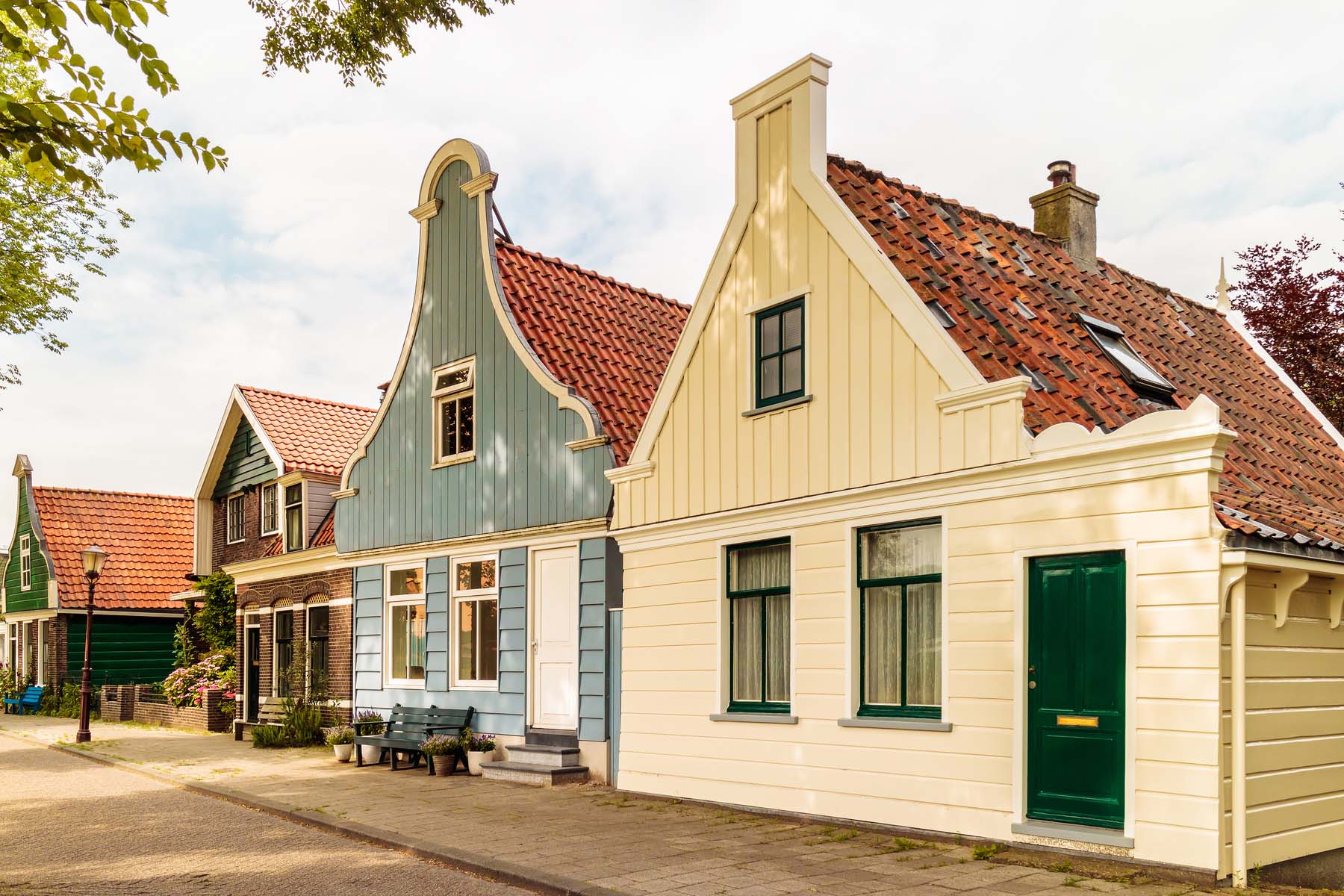
Housing in Noord
Though rarely available, Noord is home to beautiful Dutch family homes in its old fishing villages. There are also lots of newly built houses and apartments in Noord. Prices are more affordable than in the center and surrounding areas.
Why should you live in Amsterdam Noord?
Noord is ideal for those seeking family homes close to the city center. It boasts a wonderful sense of community within each of its village-like areas and also has a prospering cultural scene. Combined with the tranquility of its open spaces and good transport links to the center, you can see why so many expats chose to live here.
Amsterdam Oost
Oost is one of the city’s most vibrant and ethnically diverse districts. It stretches from the Plantage area, along the Eastern Docklands and its chic waterside apartments towards the multicultural Indische buurt. Its many different communities give Oost an eclectic feel. More and more hip bars and restaurants are popping up in Oost and the diversity of cultural activity and events on offer draw a young, experimental crowd. There are a number of parks and green spaces, which alongside good schools and slightly more spacious homes, make it a popular choice for families.
Environment in Oost
Oost has historically been a green refuge for the city of Amsterdam. Amsterdam’s oldest park can be found in Oost. It’s also home to ARTIS, the city’s acclaimed zoo, famed for the diversity of its fauna.
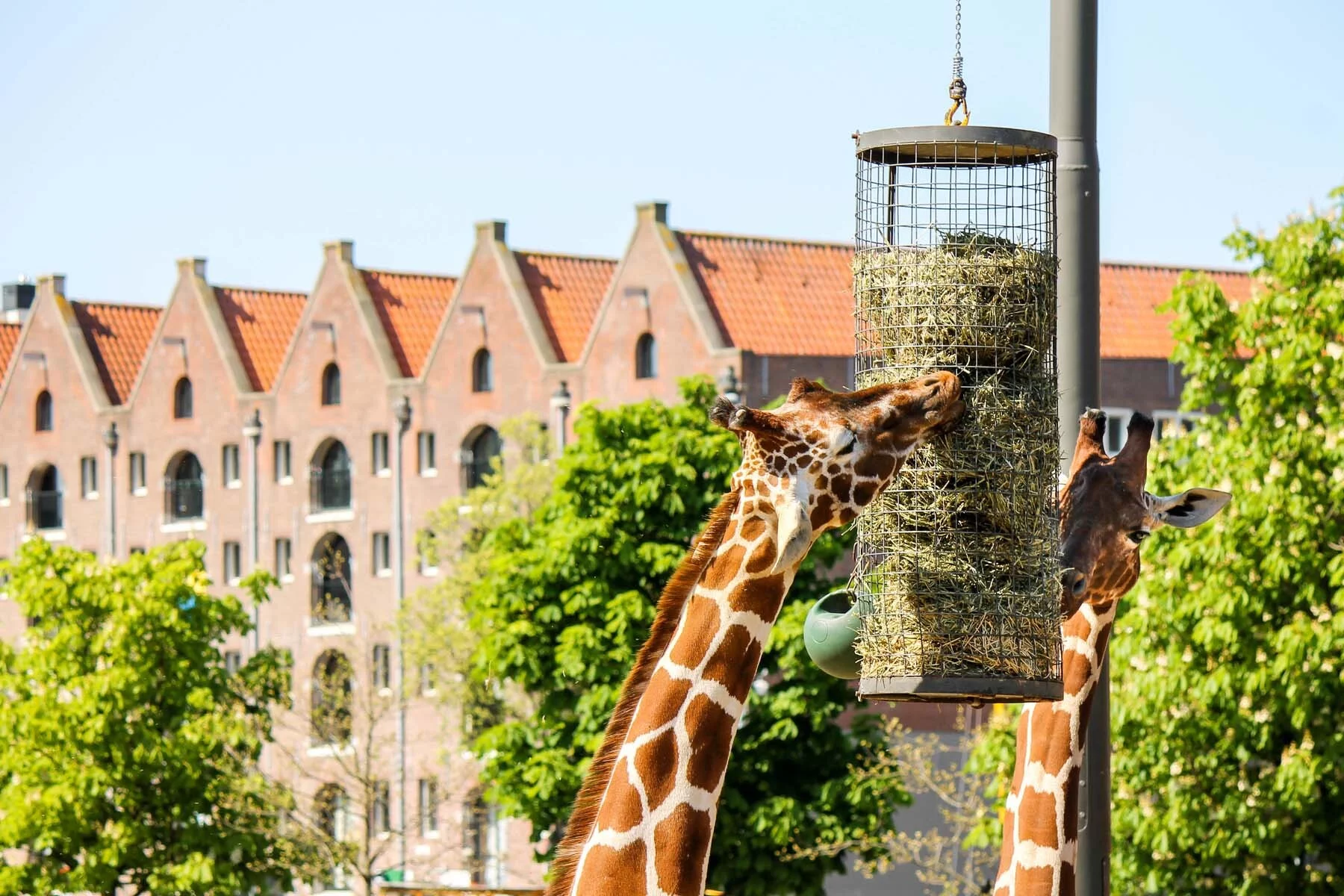
Also in the district is Oosterpark, a sprawling green space, overlooked by the monumental Wereldmuseum Amsterdam, which celebrates world cultures. To the south lies Park Frankendael, home to the celebrated plant-to-plate Restaurant De Kas. Its iconic greenhouse was once a nursery for Amsterdam’s trees. Finally, on Oost’s eastern perimeter lies Flevopark, home of ‘t Nieuwe Diep jenever distillery.
In contrast to the pricier Watergraafsmeer and Oosterpark neighborhoods, Dapperbuurt and Indische buurt were built for the working classes. Today, you’ll find the streets here lined with Turkish bakeries, Surinamese supermarkets, and Middle Eastern bistros. Furthermore, an increasingly younger demographic has also brought trendy bars, vegan pop-ups, and independent stores into the mix.
The growth of new communities in Oost is ongoing on its newly formed islands. The newest of these is IJburg, which even has its own beach. These islands are home to some of Amsterdam’s most prized real estate – and there are more in the pipeline!
Facilities around Oost
Cultural hotspots in Oost include gems like NedPhO-Koepel, home of the Netherlands Philharmonic and Chamber Orchestras; Framer Framed, where contemporary art meets progressive debate and Mezrab where storytelling and spoken word are brought to life.
The Dappermarkt is an institution in Oost, celebrated for the ethnic diversity of its 200 stalls. The Oostpoort shopping area offers a more commercial shopping experience, with a mix of chain stores and independent outlets. It also has a number of leisure facilities and restaurants. Oost is also known for its independent, vintage, and artisan stores.
The OLVG hospital has one of its largest sites in Amsterdam Oost and the area is well set up for families with good schools and playgrounds. Two of Amsterdam’s university campuses are located in the district, resulting in a young demographic and numerous facilities.
Transport in Oost
Oost is well-connected to the rest of the city by public transport. Services to the east of the Netherlands run from Amstel and Science Park stations. Moving further east, parking becomes easier, but cycling remains the most popular form of transport.
Housing in Oost
Around the Plantage and Oosterpark, there are traditional townhouse apartments. Along the waterfront and in the Plantage, there are also modern apartment buildings offering more spacious accommodation. If you’re lucky you may even find yourself overlooking the zoo! Further east towards Dapperbuurt and Indische buurt the housing gets more affordable. Most of the accommodation in this area was built as social housing, though the demographic now is more diverse. In Watergrafsmeer, traditional Dutch-style homes offer more space for families, though they come with a hefty price tag.
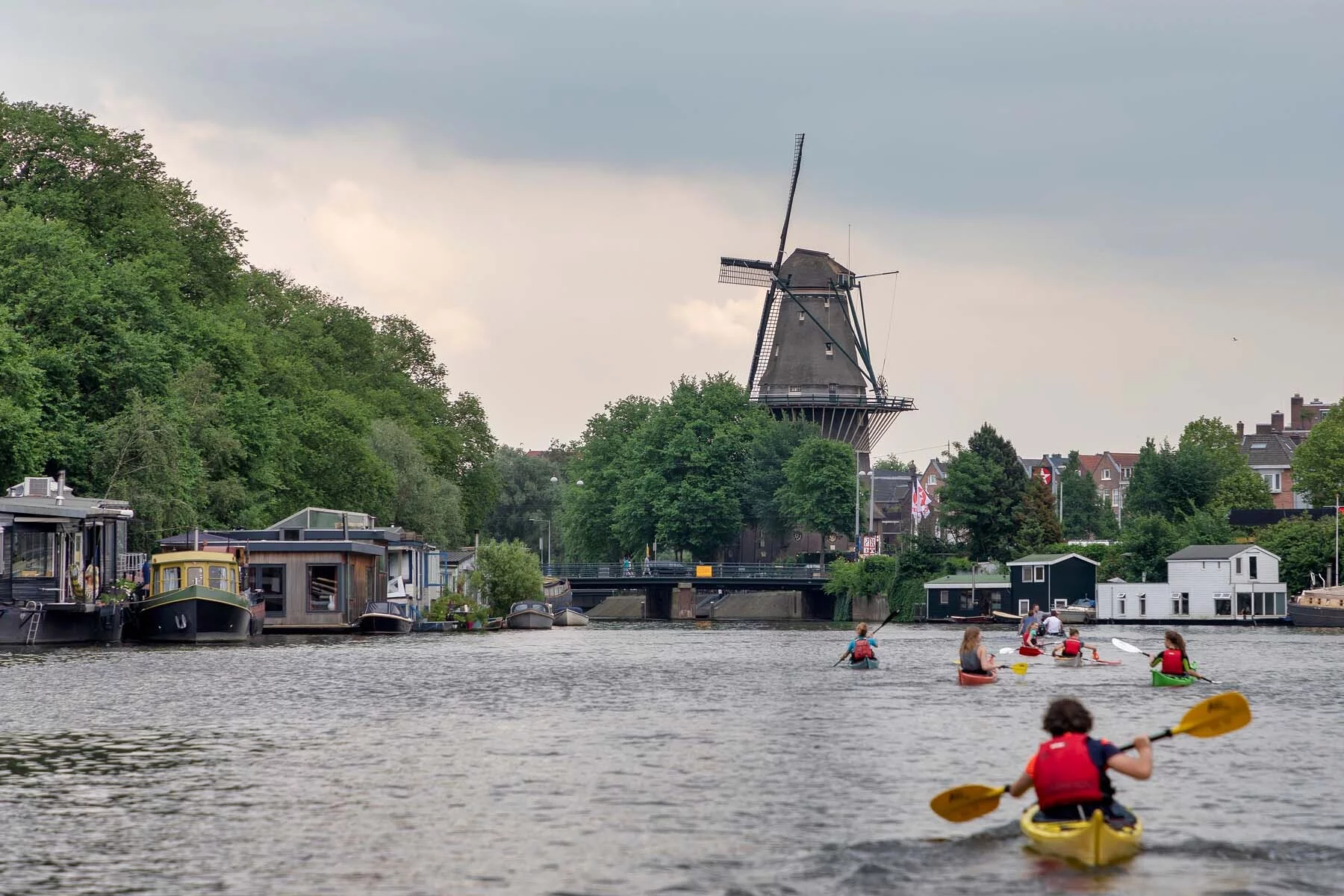
If you’re willing to head beyond Flevopark, you will discover the newly built residential complexes on Zeeburg Eiland (in Dutch). The first new neighborhood, Sportheldenbuurt, is centered around an expansive and creatively landscaped open-air skatepark.
The islands offer modern apartments and newly built houses. Many are modern reimaginings of traditional Amsterdam homes with their own unique appeal. Many residents of Oost also opt to live in houseboats on the water itself.
Why should you live in Amsterdam Oost?
Oost is best for those who wish to live in a culturally diverse part of the city with plentiful parks. It’s particularly good for families, offering more spacious living. Its proximity to open water areas also makes it ideal for fans of watersports.
Amsterdam Zuidoost
Multicultural and diverse, Zuidoost may be the Amsterdam district most overlooked by expats. It may be a far cry from Amsterdam’s iconic canals and townhouses, but with over 130 different nationalities, Zuidoost is a cultural melting pot with a lot to offer.
Everything in the district is large-scale, from its high-rise apartments and megastores through to the gigantic Johan Cruijff ArenA, home of Amsterdam’s celebrated football team, Ajax. Around the stadium is a large entertainment complex of restaurants and shops. Slightly further afield, the district also offers vast green spaces and picturesque waterways.

Environment in Zuidoost
Zuidoost is a relatively new district, born in the 1950s and 1960s in response to a need for more housing in Amsterdam. This need resulted in the tall high-rises that populate the district.
Within the district are the notable residential neighborhoods, Bijlmermeer (also called Bijlmer) and Gein. The Bijlmer became home to a large Surinamese community when the country gained independence in 1974.
Though the area around the station is fairly built up, Zuidoost is also home to several green spaces including the scenic Diemerbos, home of the House of Bird (in Dutch) café/beer tasting room. Gaasperplas park is also noteworthy. The park surrounds a manmade lake which is a hotspot for watersports (in Dutch) and boating activities (in Dutch).
Although the area has a reputation for a higher crime rate than the rest of Amsterdam, in recent years the area has shed this image and is now considered to be much safer (in Dutch).
Facilities around Zuidoost
The district’s hub is centered around the Johan Cruijff ArenA. Across from the arena is Amsterdamse Poort, Amsterdam’s largest shopping area which is also notable for its tokos (Indonesian takeaways). The Amsterdam branch of IKEA is also located in Zuidoost.
The eclectic backgrounds of its residents, combined with the large event spaces located in Zuid-Oost have made the district a hotbed of cultural activity. The highlight is the annual Kwaku Festival with live performances, debates, delicious food stalls, and even a football competition.
Food lovers will enjoy living in close proximity to the World of Food where 25 kitchens offer international cuisines from all over the globe.
There are several schools in the district. Many of these are multicultural schools that have students from a range of backgrounds. Families can also enjoy a number of cultural and sporting facilities in the district, from large open parks like Gaasperplas to the indoor play paradise Ballorig – perfect for rainy days.
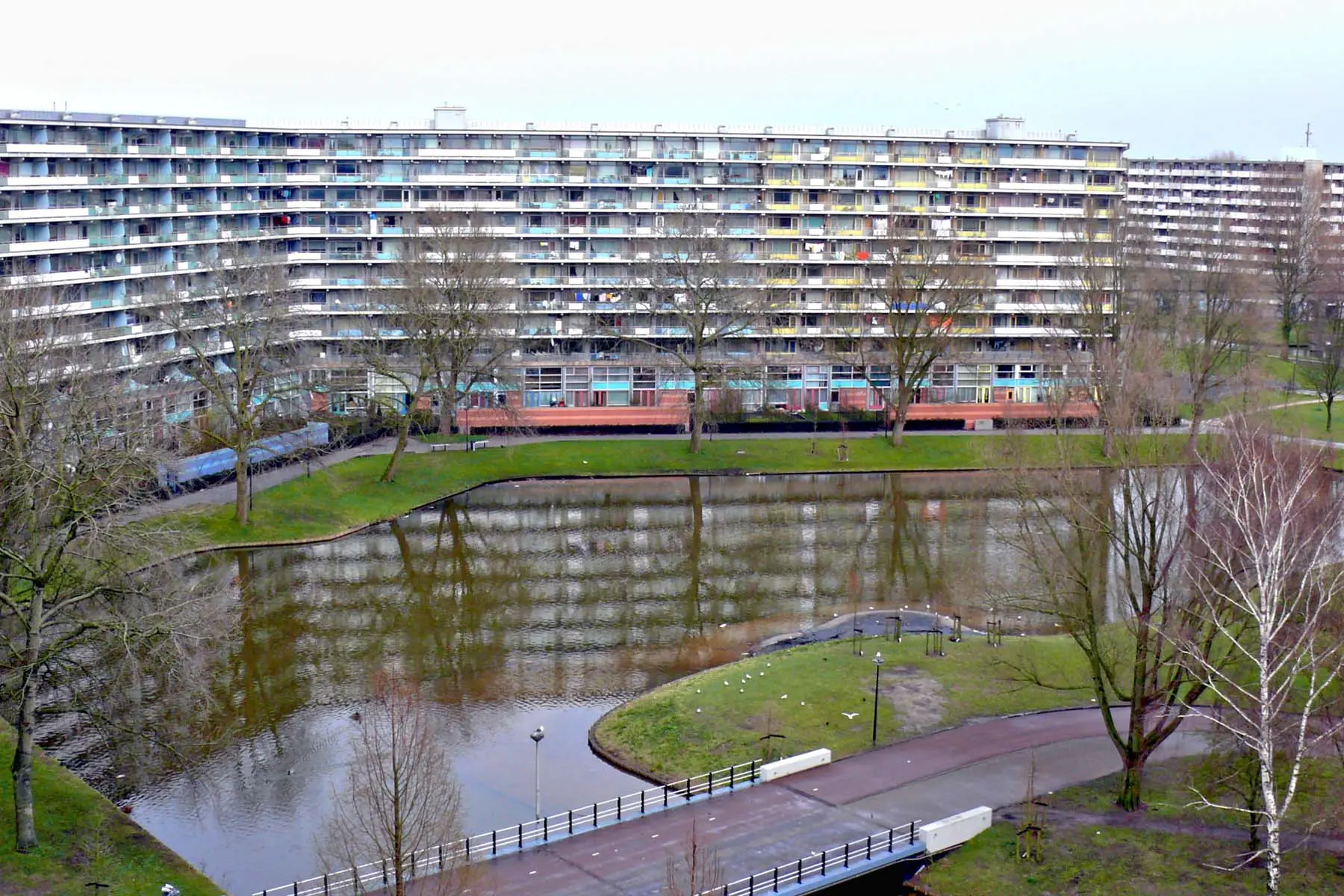
Transport to Zuidoost
Cycling from Zuidoost into the center of Amsterdam takes about 45 minutes to an hour. However, there are good bus and metro connections.
There is ample space for parking and a lot of people living in Zuidoost travel by car.
Housing in Zuidoost
Most residents in the district live in high-rise apartments. Housing in Zuidoost is cheaper than in other districts in the city, particularly the further out from the center you live. However, the area around the Johan Cruijff ArenA is a little more expensive.
Why should you live in Amsterdam Zuidoost?
If you’re a dedicated Ajax fan, then this is definitely the district for you. Zuidoost offers easy modern living with good access to commercial shopping facilities, international cuisines, and large event spaces. It’s also a good option for anyone wanting to live in Amsterdam but work in areas to the east, such as Utrecht.
Amsterdam Zuid
Amsterdam Zuid is perhaps the most elegant and bourgeois district of the city. Stretching south from Museumplein, which is home to Amsterdam’s most iconic museums, Zuid also takes in the once working-class De Pijp neighborhood, that’s now one of the city’s coolest areas, and the international Rivierenbuurt, a family favorite.
On the western side of the district beyond the southern end of Vondelpark, the area is characterized by wide boulevards and the distinctive staircases of its houses. It’s a very popular neighborhood with expat families, with plenty of playgrounds, quiet streets, and family-friendly cafes.
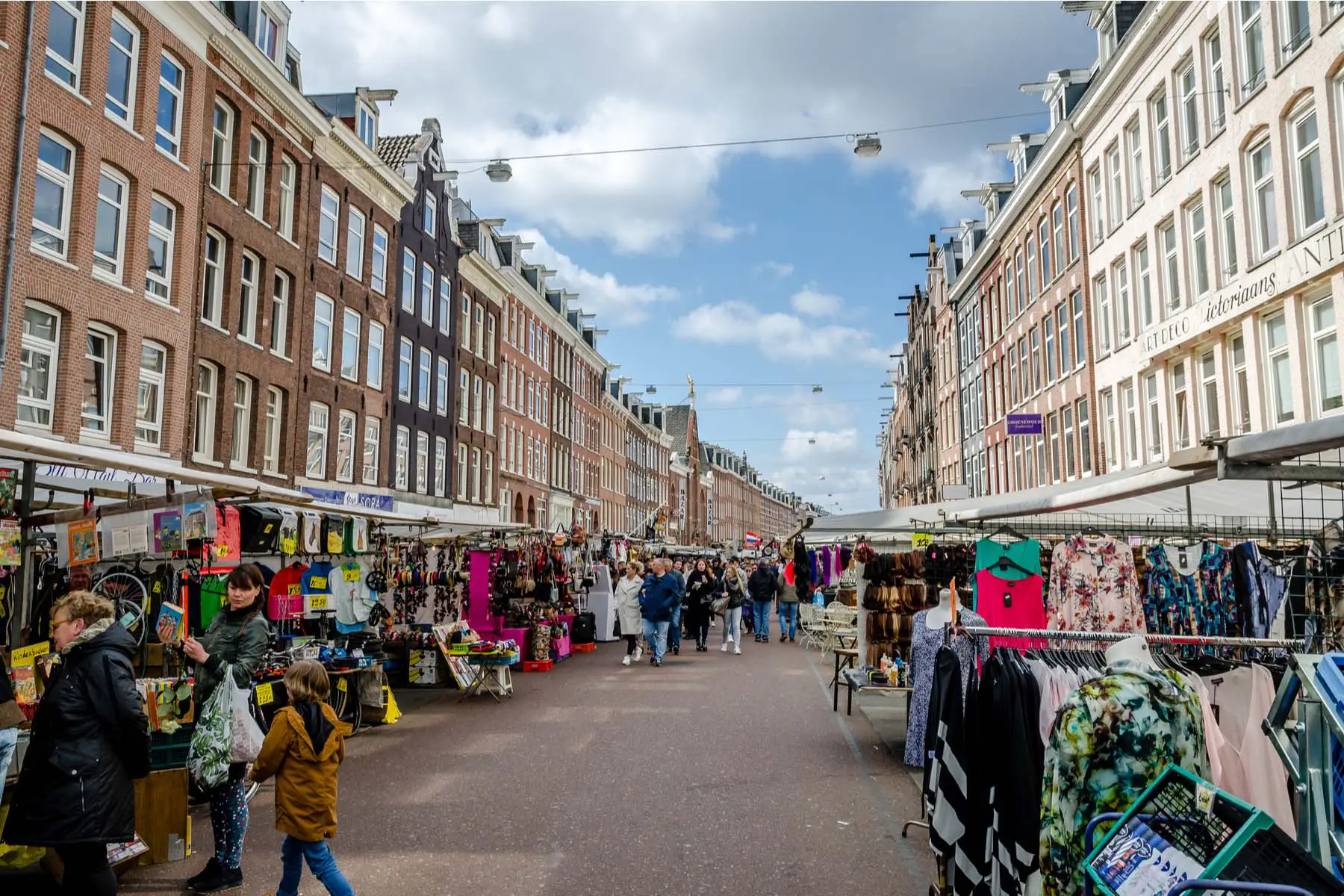
Environment in Zuid
Of all the districts, Zuid is the most geared toward expat families. Most of Amsterdam’s international schools and businesses are located here.
Whilst younger internationals may prefer the edginess of De Pijp, many families settle in peaceful, family-friendly neighborhoods like Apollobuurt and Rivierenbuurt.
Enjoying national heritage status, Vondelpark is the city’s most-visited and loved green space. The huge Amsterdamse Bos – three times bigger than New York’s Central Park – is also located in Zuid, offering woodland areas and plenty of activities.
Facilities around Zuid
The most famous museums in Amsterdam, including the Van Gogh Museum and the Rijks Museum, are all located within the district’s prestigious Museum Quarter. A short stroll from here is PC Hooftstraat, the chicest shopping street in Amsterdam where even if your budget won’t allow you to buy, you can window-shop at Chanel, Prada, and Dior.
The majority of Amsterdam’s international schools and daycare facilities are located in Zuid. It’s also home to the Zuidas Business District where a number of international companies and institutions are based.
International schools in the district include:
- The British School
- The Amsterdam International Community School
- The International French School
- The Lycée Français Vincent van Gogh School
- Winford Bilingual Primary School
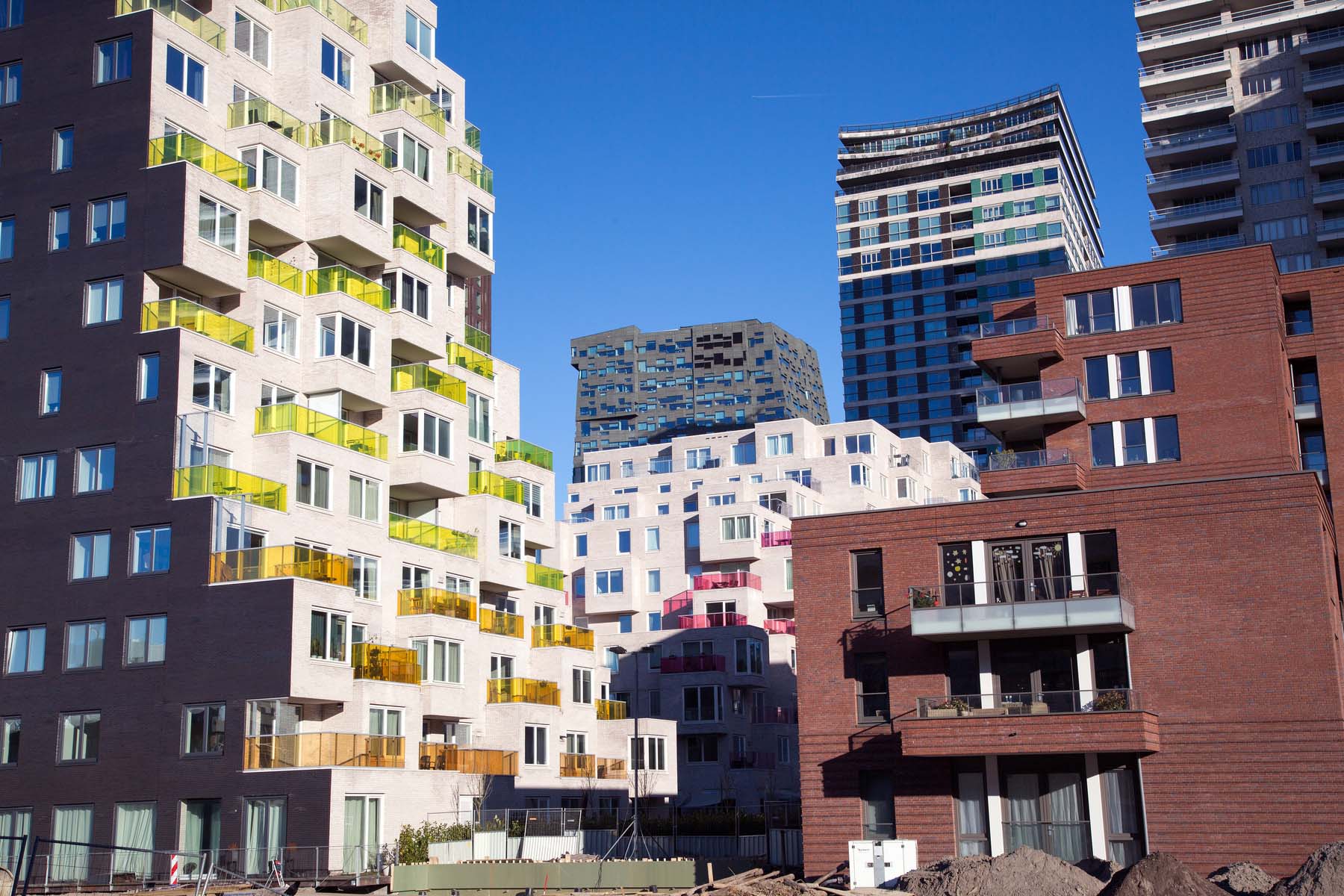
Transport to Zuid
The Zuidas Business District is located in the center of Zuid. Traveling to Centrum and further afield is easy with good links by tram, metro, train, and bus. However, bikes remain the main form of transport in the area. Many families opt for cargo bikes (bakfiets) to ferry kids around.
Housing in Zuid
Zuid is a mix of grand townhouses, mansions, and distinctive apartment blocks built as part of the 1917 Plan Zuid. These sweeping long blocks are emblematic of the Amsterdamse School of architecture. Prices are more reasonable the further towards the ring road you go.
Why should you live in Amsterdam Zuid?
Zuid is perfect for expat families and young internationals. The grandiose streets around Vondelpark and Museumplein might be out of reach for most, but Zuid has a great family-friendly feel that blends with its distinctive heritage.
Amsterdam West
Cozy and welcoming West roughly lies between three of Amsterdam’s most popular green spaces: Vondelpark, Rembrandtpark, and Westerpark. Here, the striking buildings of the city’s former gasworks have been transformed into a vibrant cultural hotspot. The district encompasses several lively neighborhoods, including the lively Oud-West with its many restaurants and independent stores and the culturally diverse Bos en Lommer and De Baarsjes. Amsterdam West is historically a residential area and it retains a peaceful vibe. Traces of its history remain evident in the mix of architectural styles and repurposing of old buildings, particularly around Westerpark and the Oud-West.
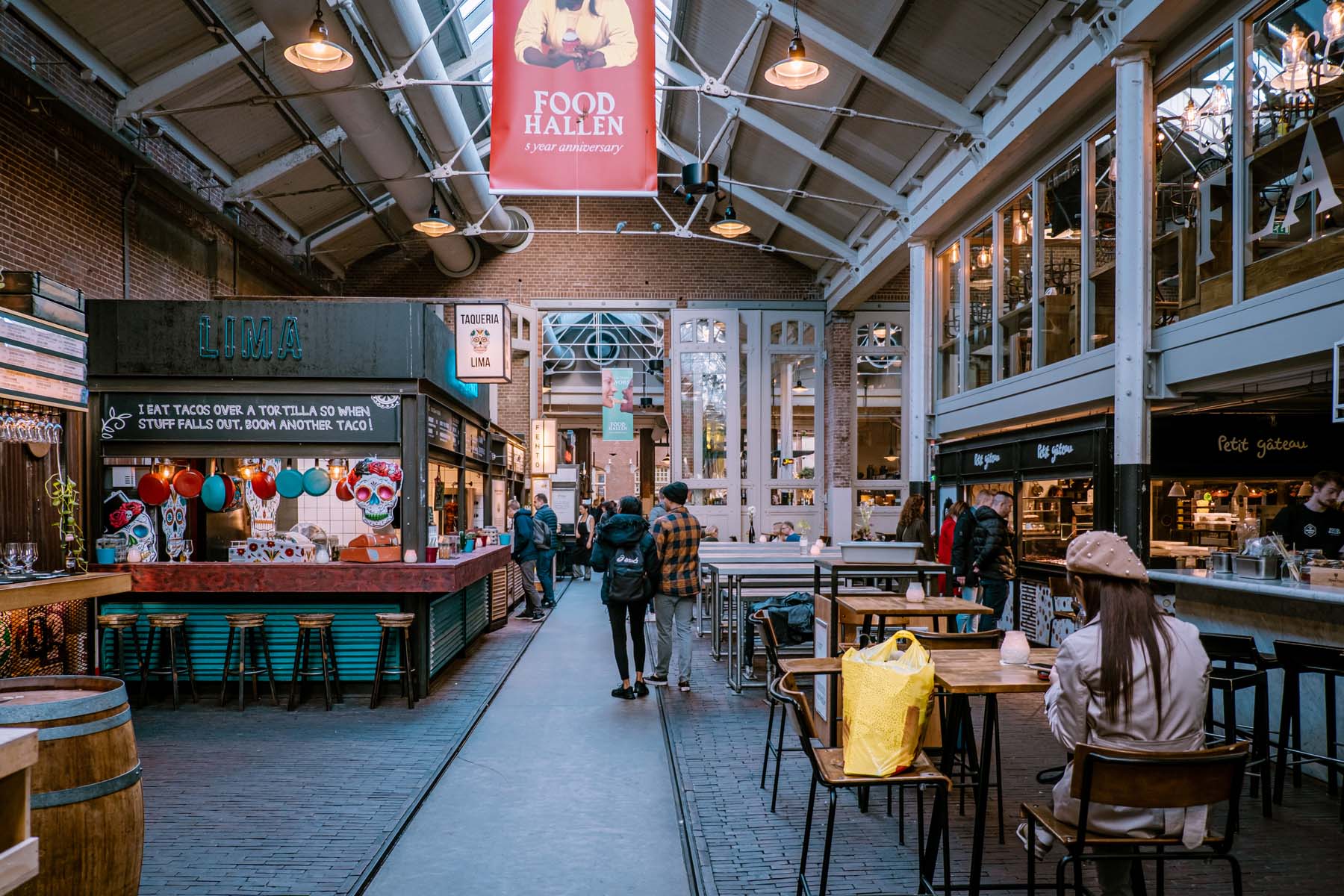
Environment in West
Amsterdam West is incredibly popular with families. In addition to the parks mentioned above, there is also the smaller yet perfectly formed Erasmuspark. Parents can sip a beer at the park’s child-friendly cafe and enjoy tasty food whilst watching their kids play. Many of the best children’s farms, playgrounds, and (for those warmer days) paddling pools are located in West. The district also offers plenty of good Dutch schools, many of which are popular with expat families.
The many bars and restaurants of Oud-West attract a vibrant, largely local crowd to their terraces. Meanwhile, every taste and need is catered for at De Hallen, Amsterdam’s former tram shed turned food hall and cultural hotspot which also includes a cinema.
Facilities around West
Many expat families happily make use of the many local Dutch schools in the area. To find a local Dutch school with a strong international community, parents can consult the Amsterdam Mama’s Facebook group. Located in De Baarsjes, families can also find De Visserschool, a Dutch tweetalige (bilingual) school.
For municipal affairs, residents of West can arrange an appointment at the local city office on Bos en Lommerplein.
The many bars, restaurants, and independent stores of Oud-West’s shopping streets attract a young and vibrant crowd. De Hallen, draws tourists and locals alike for its many culinary and cultural offerings. Just next to the tram shed building is the popular Ten Katemarkt which has an international allure.
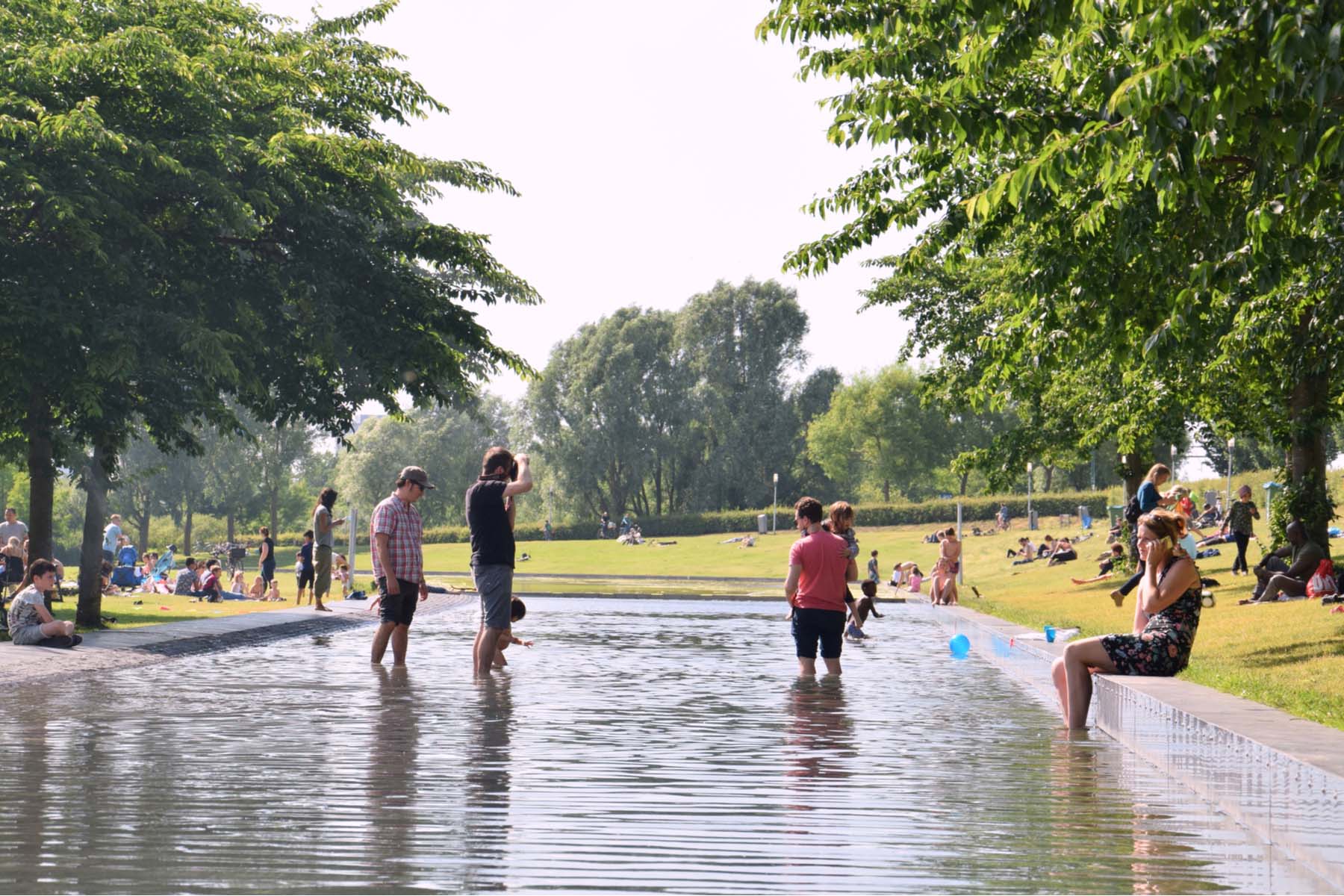
At Westergas, the city’s 19th-century former gasworks, residents and visitors will find trendy bars, restaurants, and pop-up stores. It’s also home to the Ketelhuis (in Dutch), one of Amsterdam West’s many independent cinemas.
Transport to West
For those who prefer not to cycle, tram and bus routes provide easy connections to the Centrum and around Amsterdam. Amsterdam Sloterdijk station, in the northwest of the district, offers connections to Schiphol, The Hague, and Haarlem. Permit parking is possible, though in some areas there are waiting lists.
Housing in West
As a predominantly residential area, there is a good chance you will find a suitable home in West. Most homes are apartments, though it’s possible to find a range of sizes to meet your needs. Westerpark and Oud-West, being closer to the Centrum and the cultural buzz of Amsterdam, are more costly than the largely residential areas of Bos en Lommer and De Baarsjes.
Why should you live in Amsterdam West?
West offers a cozy and homely slice of Amsterdam life without the inconvenience of the tourist throng. Its open green spaces, cultural pockets, and many family activities make it ideal for expat families and young people alike – particularly given its close proximity to the center of town.
Amsterdam Nieuw-West
Several waves of construction during the 1950s led to the creation of Amsterdam’s Nieuw-West district. Stretching west from Rembrandtpark through the neighborhoods of Osdorp, Guezenveld-Slotomeer, and Slotervaart, the district is notable for its open green spaces and lakeside tranquility. Purpose-built residencies and innovative high-rises were built with the creation of a new community in mind.
The district is also home to two of the city’s largest lakes (Sloterplas and Nieuwe Meer) and even has its own nature reserves. Its green spaces combined with its proximity to the center make the Nieuw-West popular amongst families and sports enthusiasts.
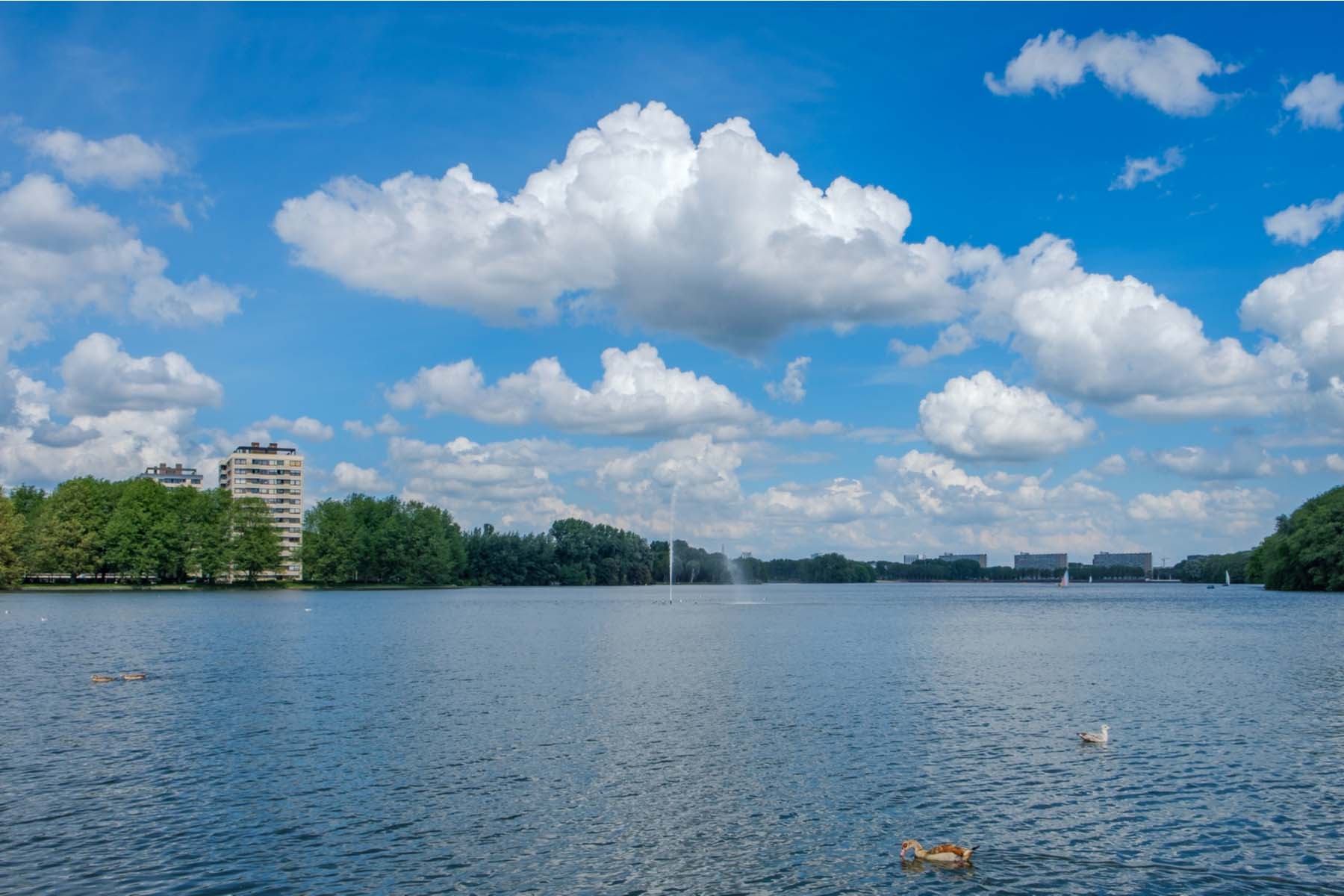
Environment in Nieuw-West
In addition to the several playgrounds, petting zoo, and outdoor exercise areas of Rembrandtpark, families venturing further out into the district will discover numerous other green open spaces. It’s easy to while away a sunny day on the beaches at Sloterplas or on the banks of the Nieuwe Meer, where you may even spot a highland cow. Equally pleasant are long winding cycle rides through the tall grasses of the Lange Bretton nature reserve (in Dutch) or days out to the many pick-your-own farms in the district.
Facilities around Nieuw-West
If you like water sports, the huge Sloterplas lake is a big draw. There’s also an Olympic-sized swimming pool on the lakefront. Nieuw-West also has a few cultural venues, notably the Meervart Theatre. Increasingly, more and more exciting restaurants and bars are popping up.
Limited international stores can be found at Osdorpplein and Akerpoort. For groceries, residents will find plentiful international produce along Burgemeester de Vlugtlaan.
The Nieuw-West has a lot to offer families. At Fruituin van West, you can pick your own fruit and enjoy a tasty meal. There is also a petting zoo in Osdorp and a fantastic nature playground with children’s activities next to the Sloterplas.
There are a number of good schools in the district, including the DENISE International School which offers bilingual learning, and the Japanese International School.
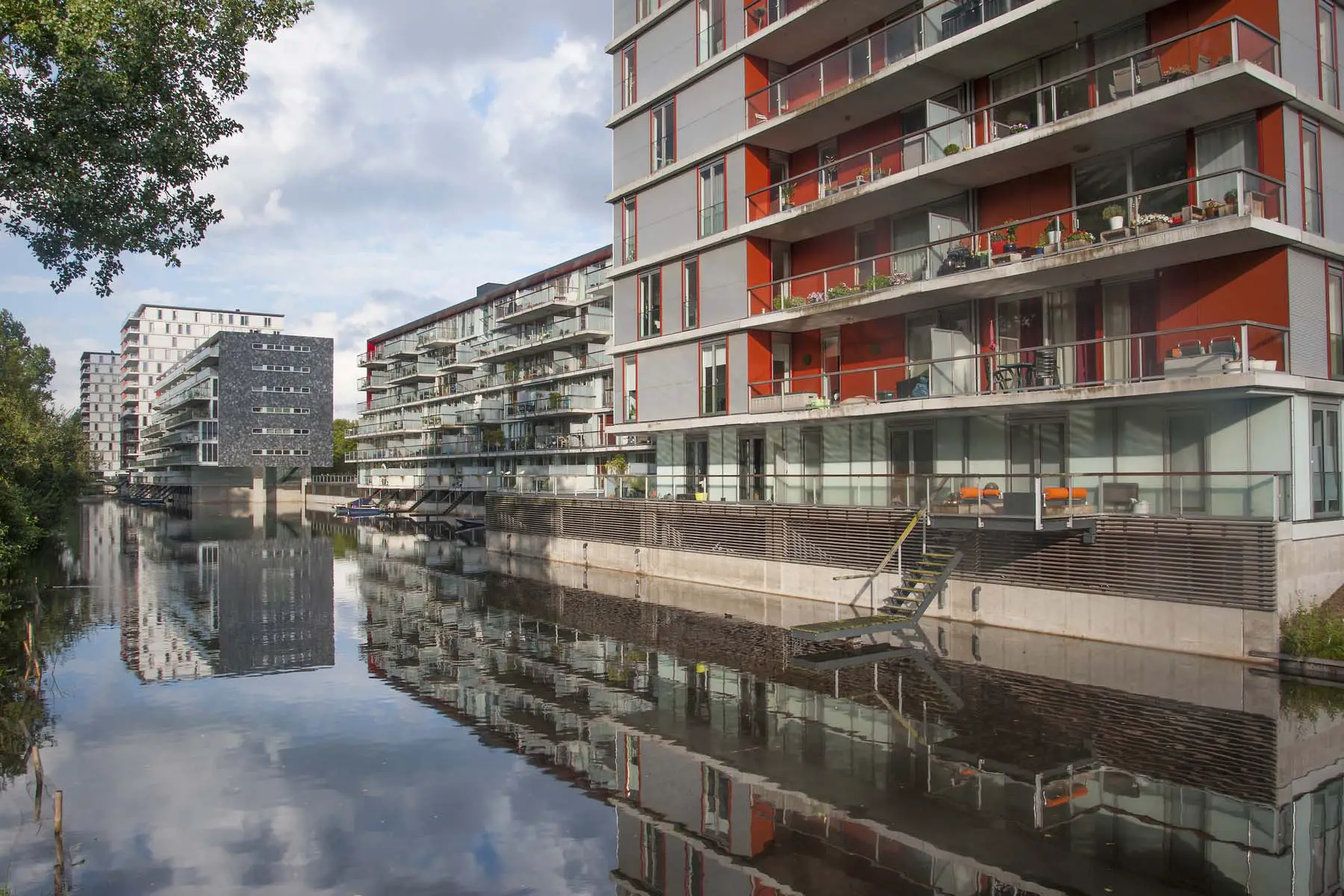
Transport to Nieuw-West
Residents of Nieuw-West can enjoy reliable and frequent transport connections to the rest of Amsterdam. Lelylaan station also offers fast train connections to Schiphol, Rotterdam, and The Hague.
The district is also suited to car owners. Many newer properties include parking facilities and there are also on-street parking options.
Depending on how far West you live, cycling to the city center can take up to an hour.
Housing in Nieuw-West
It’s possible to find more affordable apartments and even houses in Nieuw-West, particularly as you travel further away from the center. Lots of this housing is relatively new.
Why should you live in Amsterdam Nieuw-West?
Living in Nieuw-West is ideal for nature lovers, outdoor sports enthusiasts, and those who prefer quieter and more affordable living, whilst still being within a reasonable distance of the city center. It’s also a good option for anyone needing fast connections to Schiphol and cities in the west.
Neighborhoods to avoid in Amsterdam
Amsterdam is recognized as the second safest city in Europe by the 2021 Safe Cities Index. It is virtually free from violent crime and there is little need for expats to consider crime rates when choosing a neighborhood in Amsterdam.
As most people in the city travel by bike, there are also fewer traffic accidents in Amsterdam than in other cities. Furthermore, all neighborhoods in the Amsterdam area enjoy good transport connections, making them suitable options for most families.
As a city with 881,000 bikes, it’s no surprise that the most common crime in Amsterdam is bike theft. However, this happens throughout the city and isn’t exclusive to any particular neighborhood.
Expats contemplating which neighborhoods to avoid needn’t consider safety issues as a deciding factor. Instead, the price and type of housing available, proximity to work, school, and leisure facilities, and the general feel of a neighborhood are more appropriate considerations.
Tips on choosing a neighborhood in Amsterdam
Expats who have secured jobs prior to arriving in Amsterdam may benefit from discussing places to live with their colleagues. Of course, in such instances, proximity to the workplace may be a guiding factor.
For families with children, the Amsterdam Mamas website is an invaluable resource. There is an endless amount of information available on this site. Their Facebook page also contains many live discussions over schools in each neighborhood, with a particular focus on the needs of expat families.
Useful resources
- iAmsterdam city guide
- City of Amsterdam website
- Moving to Amsterdam guide from Dutch Review
- Amsterdam Mamas – information for expat families in Amsterdam
